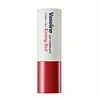What's inside
What's inside
 Key Ingredients
Key Ingredients

No key ingredients
 Benefits
Benefits

 Concerns
Concerns

 Ingredients Side-by-side
Ingredients Side-by-side

Caprylic/Capric Triglyceride
MaskingDiisostearyl Malate
EmollientHydrogenated Polyisobutene
EmollientSynthetic Wax
AbrasiveBis-Diglyceryl Polyacyladipate-2
EmollientButyrospermum Parkii Butter
Skin ConditioningMicrocrystalline Wax
Emulsion StabilisingPetrolatum 3%
EmollientPolyglyceryl-2 Triisostearate
EmulsifyingSilica
AbrasiveSilica Dimethyl Silylate
EmollientSorbitan Isostearate
EmulsifyingCI 15985
Cosmetic ColorantCI 15850
Cosmetic ColorantTitanium Dioxide
Cosmetic ColorantCI 77492
Cosmetic ColorantParfum
MaskingPentaerythrityl Tetra-Di-T-Butyl Hydroxyhydrocinnamate
AntioxidantDehydroacetic Acid
PreservativeHoney Extract
HumectantBHT
AntioxidantPhenoxyethanol
PreservativeEthylhexylglycerin
Skin ConditioningCaprylic/Capric Triglyceride, Diisostearyl Malate, Hydrogenated Polyisobutene, Synthetic Wax, Bis-Diglyceryl Polyacyladipate-2, Butyrospermum Parkii Butter, Microcrystalline Wax, Petrolatum 3%, Polyglyceryl-2 Triisostearate, Silica, Silica Dimethyl Silylate, Sorbitan Isostearate, CI 15985, CI 15850, Titanium Dioxide, CI 77492, Parfum, Pentaerythrityl Tetra-Di-T-Butyl Hydroxyhydrocinnamate, Dehydroacetic Acid, Honey Extract, BHT, Phenoxyethanol, Ethylhexylglycerin
Cera Microcristallina
Emulsion StabilisingOctyldodecanol
EmollientHydrogenated Polydecene
EmollientCetyl Palmitate
EmollientRicinus Communis Seed Oil
MaskingMyristyl Myristate
EmollientVp/Hexadecene Copolymer
Cetearyl Alcohol
EmollientPolyglyceryl-3 Diisostearate
EmulsifyingButyrospermum Parkii Butter
Skin ConditioningCaprylic/Capric Triglyceride
MaskingPentaerythrityl Tetraisostearate
EmollientVp/Eicosene Copolymer
C20-40 Alkyl Stearate
Skin ConditioningPanthenol
Skin ConditioningCopernicia Cerifera Cera
EmollientCera Alba
EmollientWater
Skin ConditioningGlycerin
HumectantLimonene
PerfumingLinalool
PerfumingBenzyl Alcohol
PerfumingBenzyl Benzoate
AntimicrobialCitral
PerfumingParfum
MaskingCera Microcristallina, Octyldodecanol, Hydrogenated Polydecene, Cetyl Palmitate, Ricinus Communis Seed Oil, Myristyl Myristate, Vp/Hexadecene Copolymer, Cetearyl Alcohol, Polyglyceryl-3 Diisostearate, Butyrospermum Parkii Butter, Caprylic/Capric Triglyceride, Pentaerythrityl Tetraisostearate, Vp/Eicosene Copolymer, C20-40 Alkyl Stearate, Panthenol, Copernicia Cerifera Cera, Cera Alba, Water, Glycerin, Limonene, Linalool, Benzyl Alcohol, Benzyl Benzoate, Citral, Parfum
 Reviews
Reviews

Ingredients Explained
These ingredients are found in both products.
Ingredients higher up in an ingredient list are typically present in a larger amount.
This ingredient is also known as shea butter. It is an effective skin hydrator and emollient.
Emollients help soothe and soften your skin. It does this by creating a protective film on your skin. This barrier helps trap moisture and keeps your skin hydrated. Emollients may be effective at treating dry or itchy skin.
Shea butter is rich in antioxidants. Antioxidants help fight free-radicals, or molecules that may harm the body. It is also full of fatty acids including stearic acid and linoleic acid. These acids help replenish the skin and keep skin moisturized.
While Shea Butter has an SPF rating of about 3-4, it is not a sunscreen replacement.
Shea butter may not be fungal acne safe. We recommend speaking with a professional if you have any concerns.
Learn more about Butyrospermum Parkii ButterThis ingredient is an emollient, solvent, and texture enhancer. It is considered a skin-softener by helping the skin prevent moisture loss.
It helps thicken a product's formula and makes it easier to spread by dissolving clumping compounds.
Caprylic Triglyceride is made by combining glycerin with coconut oil, forming a clear liquid.
While there is an assumption Caprylic Triglyceride can clog pores due to it being derived from coconut oil, there is no research supporting this.
Learn more about Caprylic/Capric TriglycerideParfum is a catch-all term for an ingredient or more that is used to give a scent to products.
Also called "fragrance", this ingredient can be a blend of hundreds of chemicals or plant oils. This means every product with "fragrance" or "parfum" in the ingredients list is a different mixture.
For instance, Habanolide is a proprietary trade name for a specific aroma chemical. When used as a fragrance ingredient in cosmetics, most aroma chemicals fall under the broad labeling category of “FRAGRANCE” or “PARFUM” according to EU and US regulations.
The term 'parfum' or 'fragrance' is not regulated in many countries. In many cases, it is up to the brand to define this term.
For instance, many brands choose to label themselves as "fragrance-free" because they are not using synthetic fragrances. However, their products may still contain ingredients such as essential oils that are considered a fragrance by INCI standards.
One example is Calendula flower extract. Calendula is an essential oil that still imparts a scent or 'fragrance'.
Depending on the blend, the ingredients in the mixture can cause allergies and sensitivities on the skin. Some ingredients that are known EU allergens include linalool and citronellol.
Parfum can also be used to mask or cover an unpleasant scent.
The bottom line is: not all fragrances/parfum/ingredients are created equally. If you are worried about fragrances, we recommend taking a closer look at an ingredient. And of course, we always recommend speaking with a professional.
Learn more about Parfum